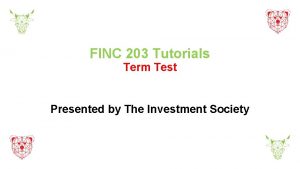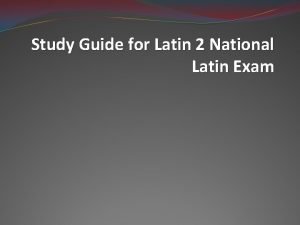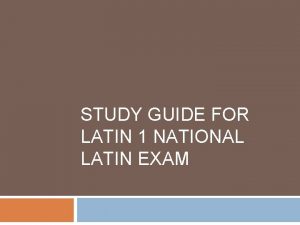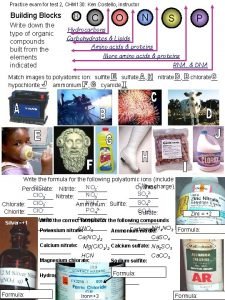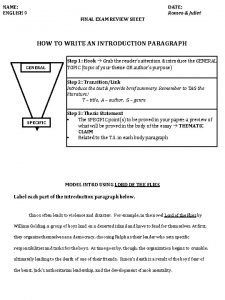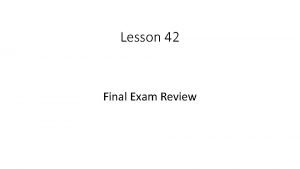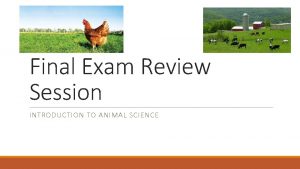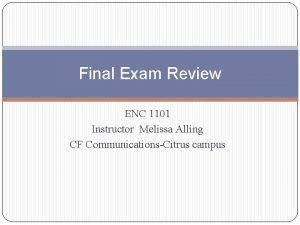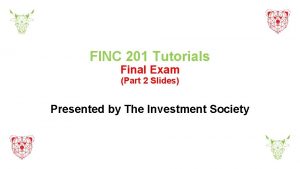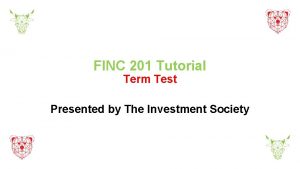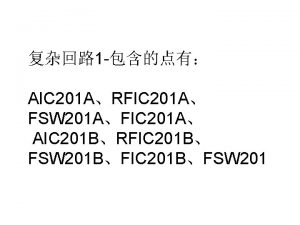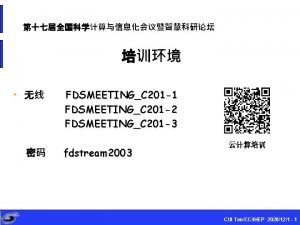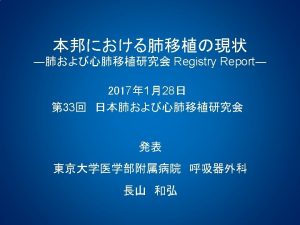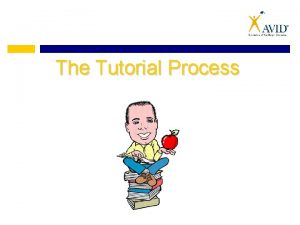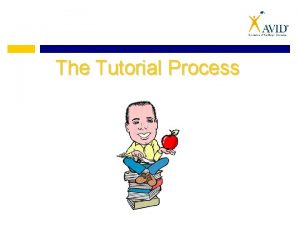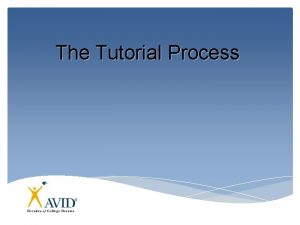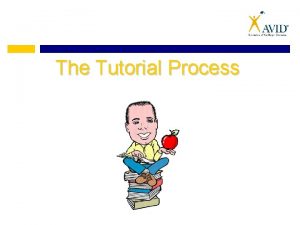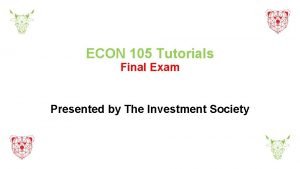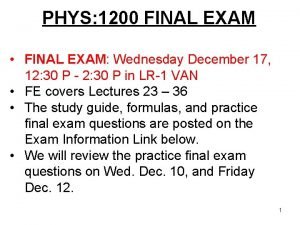FINC 201 Tutorials Final Exam Part 2 Slides




































- Slides: 36

FINC 201 Tutorials Final Exam (Part 2 Slides) Presented by The Investment Society

Overview: Part 2 • Capital Budgeting • • Sunk Costs Cannibalism Replacement Project (Incremental NPV) Unequal Lives, Replacement Chains • Risk & Return [refer to Term Test 2 Tutorial Slides] • Cost of Capital

Some things to remember

Sunk Costs • “Sunk Costs” is a term for a cost which has already been incurred • They are important to watch out for when valuing a capital budgeting project, because they are NOT incremental costs • i. e. These will be a cost to the business regardless of whether they accept the project or not • Therefore, sunk costs are ignored, and NOT included in any NPV calculations

Sunk Costs - Example • This new asset should be allocated $12, 000 of the firm’s overhead • Ignore and do not include in calculations, as overhead is just an accounting calculation for allocating fixed costs, and we know that fixed costs will happen regardless of whether we accept the project or not • It cost $8, 000 to pay the consultant for this capital budgeting projections report • Ignore and do not include in calculations, as this cost has already occurred and therefore is not incremental • The firm’s interest expense is $100, 000 per annum • Ignore and do not include in calculations, as we need to keep financing decisions separate from investing decisions

Cannibalism • “Cannibalism” is a term for when the acceptance of a new project (e. g. selling a new product) will “cannibalise” sales/revenue from an existing revenue stream (e. g. another product) • It is important to identify where this may be the case, as it will determine what is incremental, and what is not, with the NPV (or Incremental NPV) calculations

Cannibalism - Example • Product A: $100, 000 (Current Sales) • Product B: $80, 000 (Estimated Sales) • Note: If Product B is implemented, then Product A sales will fall by $35, 000 • Therefore, incremental sales are: • $80, 000 - $35, 000 = $45, 000

Net Working Capital • What is working capital? • Remember to include it in the total initial outlay in year 0 • Remember to include it in the terminal value at maturity

Initial Investment (Outlay) Costs • When purchasing an asset e. g. machine at the start of the project there are some additional cost which may be required to be capitalised and included in it’s total value, including: • Cost of shipping or transport • Cost of installation • Cost of additional parts (that are required for the asset to work) • These will impact both the Year 0 cash flow AND depreciation expense (as the book value is used on the calculation)

Question 2. 1

Question 2. 1

Question 2. 1 NPV

Question 2. 1 IRR- The rate that makes NPV= 0. Easiest to do on financial calculator. Variable Input Enter your cashflows as shown CFo -10, 000 and then click IRR and CPT. C 01 6, 500 F 01 1 C 02 3, 000 F 02 1 C 03 3, 000 F 03 1 C 04 1, 000 F 04 1 = 18. 03% for X and = 14. 96% for Y

Question 2. 1 Modified Internal Rate of Return • To determine if the project should be accepted when using MIRR, it is compared with the OCC (e. g. WACC), just the same as you would with IRR • MIRR brings outflows back to PV, takes inflows forward to FV, can calculates the implied rate of return (I/Y) • NPV and MIRR will always give consistent decisions of accept or reject (however, they might not rank a list of projects in the exact same order)

Modified Internal Rate of Return (MIRR) • To determine if the project should be accepted when using MIRR, it is compared with the OCC (e. g. WACC), just the same as you would with IRR • MIRR brings outflows back to PV, takes inflows forward to FV, can calculates the implied rate of return (I/Y) • NPV and MIRR will always give consistent decisions of accept or reject (however, they might not rank a list of projects in the exact same order)

Given a timeline of uneven cash flows Year Cash Flows for X $ 0 (10, 000) 1 6, 500 What do we do first? 2 3 4 3000 1000 ASSUME: WACC = 12%

Bring Outflows Back to PV and Inflows to. ASSUME: FV WACC = 10% Year 0 Cash Flows $ 1 (10, 000) 6, 500 2 3 4 3000 1000 PV of negative outflows = 9132. 03 = (10000) = 3, 763. 2 = 3, 360. 00 Total = (10000) N I/Y PV PMT FV 4 ? -10, 000 0 17, 255. 23 = 1, 000 Total = 17, 255. 23

Question 2. 1 • From calculator: N I/Y PV PMT FV 4 14. 61 -10, 000 0 17, 255. 23 • We would then do the same for the second investment (Y), which you can do at home. It should come out to 13. 73%.

Question 2. 1 b) Which project should be accepted if they are independent? This means we can except both projects. NPV x= 966. 01 NPVy- 630. 72 As both of these are positive, we will accept both projects. c) Which project should be accepted if they are mutually exclusive? We will accept project X as it has the highest NPV and therefore provides the most value to the firm. We can accept one project as they are mutually exclusive.

Cost of Capital

Cost of Capital • Key Formulas: WACC, CAPM & re-arranged DDM (for rs) • Calculate Market Values (this may require bond & stock valuation) • Steps are: 1. 2. 3. 4. Find MV’s Calculate Weights using MV’s Calculate Rates Plug into WACC formula

Question 2. 2

Question 2. 2 How would you approach this? What do we need to do first?

Question 2. 2 The appropriate opportunity cost of capital for this company is WACC!

Question 2. 2 So we need six (6) key numbers to calculate WACC, 3 weights and 3 rates!

NOTE: For finding weights • When we are calculating weights always use MARKET VALUE • The question may state book values, these must be ignored! • You may need to value a bond, stock or preference share to find the market value • Or some or all market values may be given to you

Market Value: Bonds Calculate Market Value of Bonds = $20, 000

Market Value: Common Stock Calculate Market Value of Common Stock = $20 x 5, 000 = $100, 000

Market Value: Preferred Stock Calculate Market Value of Preferred Stock = $28 x 1, 000 = $28, 000

Market Value: Entire Firm Calculate Market Value of Nutter Company (The Entire Firm) Total Market Value of Nutter Company = Bonds + Common Stock + Preferred Stock Total Market Value of Nutter Company = $20, 000 + $100, 000 + $28, 000 Total Market Value of Nutter Company = $148, 000

Weights of Market Values of Securities

Required Rate of Return: Bonds If bonds are issued at par, then the YTM = Coupon Rate YTM: Yield to Maturity

Required Rate of Return: Common Stock

Required Rate of Return: Preferred Stock No capital gain, based on the info given, so the dividend yield is the current rate of return!

WACC: Putting it all together …

End of Part 2 Slides Change to Part 3 Slides
 Finc 203
Finc 203 A small child slides down the four frictionless slides
A small child slides down the four frictionless slides A hockey puck sliding on smooth ice at 4 m/s
A hockey puck sliding on smooth ice at 4 m/s Fyp presentation slides
Fyp presentation slides World history spring final exam review answers
World history spring final exam review answers World history final exam study guide
World history final exam study guide Web design final exam
Web design final exam Us history semester 1 final exam
Us history semester 1 final exam Sbu final exam schedule
Sbu final exam schedule Latin 2 final exam answers
Latin 2 final exam answers National latin exam practice
National latin exam practice Street law final exam
Street law final exam Spanish 2 exam review
Spanish 2 exam review Spanish packet answers
Spanish packet answers English 11 a semester exam
English 11 a semester exam Biology second semester final exam answers
Biology second semester final exam answers Human body systems final exam
Human body systems final exam Realidades 2 final exam
Realidades 2 final exam Chemistry 151 final exam
Chemistry 151 final exam Chm 130 chapter 12 practice problems answer key
Chm 130 chapter 12 practice problems answer key Poe practice test kinematics answers
Poe practice test kinematics answers Noah carried a skateboard
Noah carried a skateboard Romeo and juliet final exam study guide
Romeo and juliet final exam study guide Mat 1033 final exam answers
Mat 1033 final exam answers 42 final exam
42 final exam Aice english general paper
Aice english general paper Ied final exam
Ied final exam Human resource management question paper pdf
Human resource management question paper pdf Hospitality and tourism final exam
Hospitality and tourism final exam Hbs eoc practice test
Hbs eoc practice test World history 1st semester midterm exam review answers
World history 1st semester midterm exam review answers Animal science final exam
Animal science final exam Entrepreneurship 1 final exam review
Entrepreneurship 1 final exam review Enc 1101 final exam
Enc 1101 final exam Spanish 2 review packet answers
Spanish 2 review packet answers Vector solutions ferpa answer key
Vector solutions ferpa answer key End of semester test environmental science b edmentum
End of semester test environmental science b edmentum
